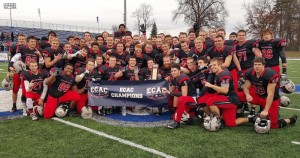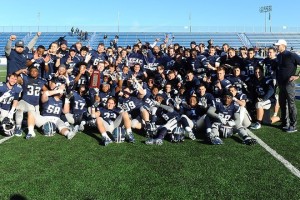By Justin Zackal
Last week concluded the second season in which all divisions of college football held tournaments to decide champions, but that doesn’t mean bowl games are becoming obsolete.
There were 38 bowl games featuring Division I teams not part of the College Football Playoff. Division III schools in the northeast affiliated with the Eastern College Athletic Conference (ECAC), including eight from the PAC, also have the opportunity to play in one of six bowl games each year.
The 2015 season marked the first time that the ECAC hosted all of its bowl games at one location, at Central Connecticut State University in New Britain, Conn., Nov. 20-22. It was also the first year PAC teams won two bowl games.
Carnegie Mellon (8-3) defeated Bridgewater State, 48-13, in the Legacy Bowl on Nov. 21, and Westminster (9-2) beat St. John Fisher, 42-21, in the James Lynah Bowl. Last year, PAC teams Waynesburg and Bethany lost in ECAC bowl games held on host team’s campuses. Previous ECAC bowl winners from the PAC included Waynesburg in 2012 and Washington & Jefferson in 2010.

Carnegie Mellon celebrates its Legacy Bowl win.
“Anytime you earn an opportunity for postseason play, I think it’s a big morale booster for your program,” said Carnegie Mellon head coach Rick Lackner, whose school remains affiliated with University Athletic Association after joining the PAC two years ago as a football-only member. “The whole atmosphere of being selected to what was available to a large number of teams, you feel honored to be selected and the represent the UAA, the PAC and certainly Carnegie Mellon University in a postseason game.”
Granted, it’s a consolation for teams not part of the 32-team NCAA Division III Championship tournament, but the ECAC bowls give 12 teams a chance to end the season on a positive note and build momentum for future inclusion in the NCAA field.
“It’s a steppingstone,” said Lackner, who in 29 seasons as head coach led the Tartans to six postseasons berths, including four ECAC bowls and a two NCAA playoff berths. “It’s also a positive thing in terms of recruiting and it’s a positive thing in terms of going into the offseason (training).”
CMU travels more than most teams, scheduling UAA schools in Chicago and St. Louis, but the Tartans rarely play in New England, which happens to be where sophomore running back Sam Benger is from (Hingham, Mass.). Benger was named Most Outstanding Player of the Legacy Bowl after rushing for 190 yards and four touchdowns on 34 carries. Benger became the 21st player in Division III history to rush for 2,000 yards in a season (2,092).
Bowl games don’t just lift the perception of the program in the eyes of current players and recruits.

Westminster after its James Lynah Bowl victory.
“The benefit was the alumni, to give the football alumni something,” said Westminster second-year head coach Scott Benzel. “There’s so much tradition, so much history here. It gave (our team) an opportunity to say, ‘Hey, look, we won something.’ That was the biggest benefit of playing in a postseason game, to make sure that that alumni knows that we are on the right track.”
Westminster won six national championships as an NAIA school from 1970-1994, but this year’s team went 9-2 for the Titans’ most wins, and third winning record, since they joined the NCAA in 1998.
The future looks bright for the Titans. A pair of sophomores, quarterback Paul Columbo and running back Dominique McKinley, helped the Titans rack up 431 total yards in their bowl win. Columbo threw for 203 yards and two touchdowns and McKinley rushed for 114 yards and a score.
Tournament play may mean there’s only one winner and every other team enters the offseason disappointed, but for Carnegie Mellon and Westminster, their success in bowl games will lead to many wins during the offseason. You can call them “morale victories.”




